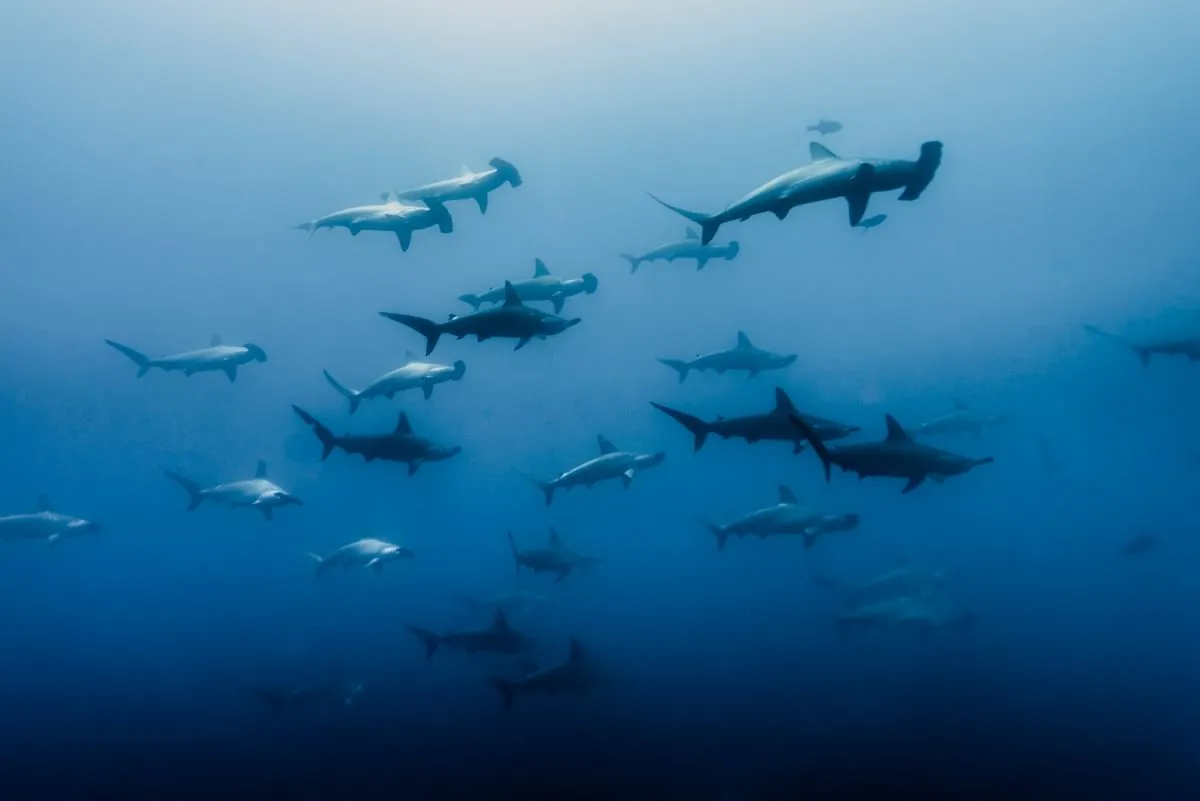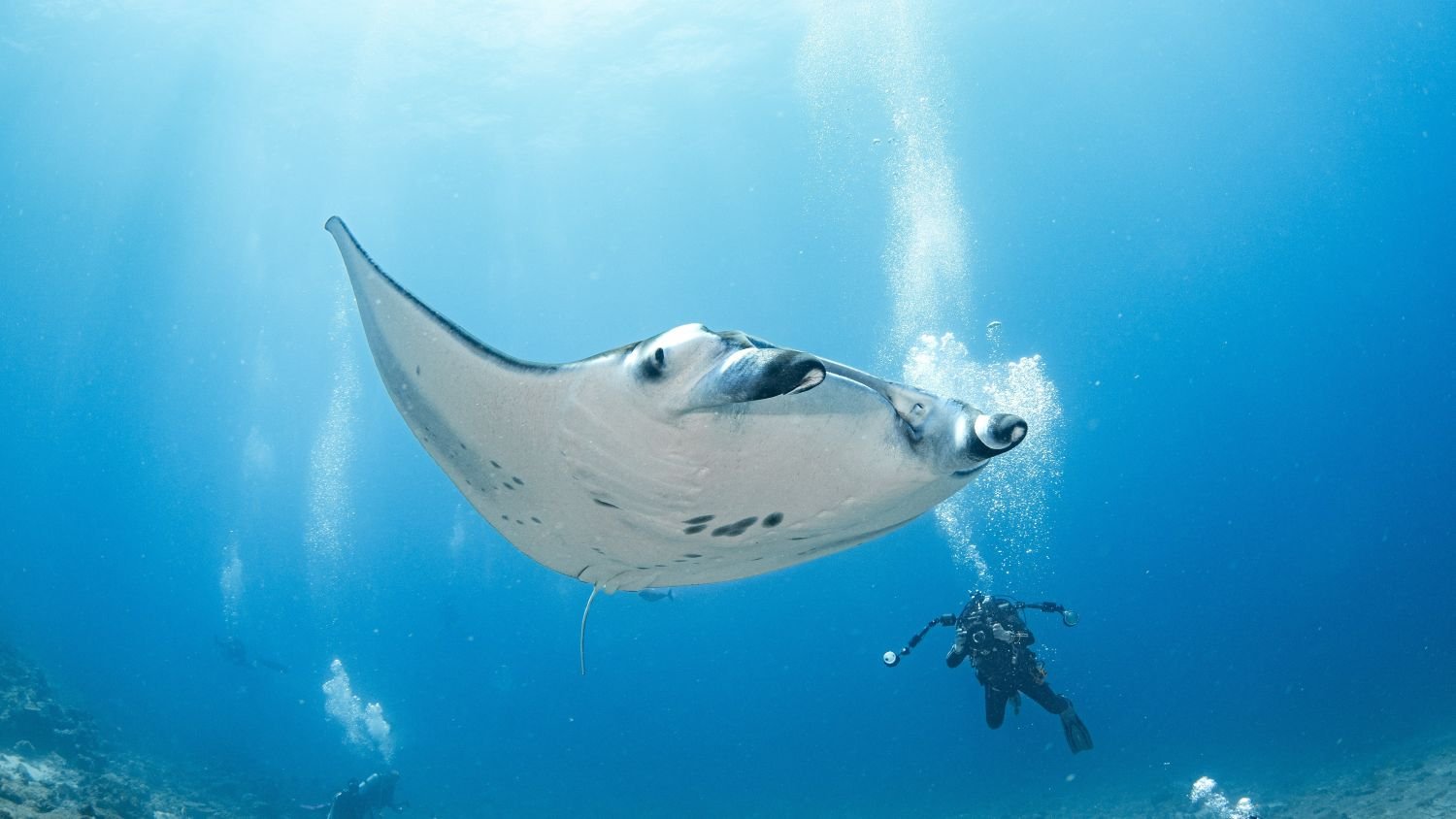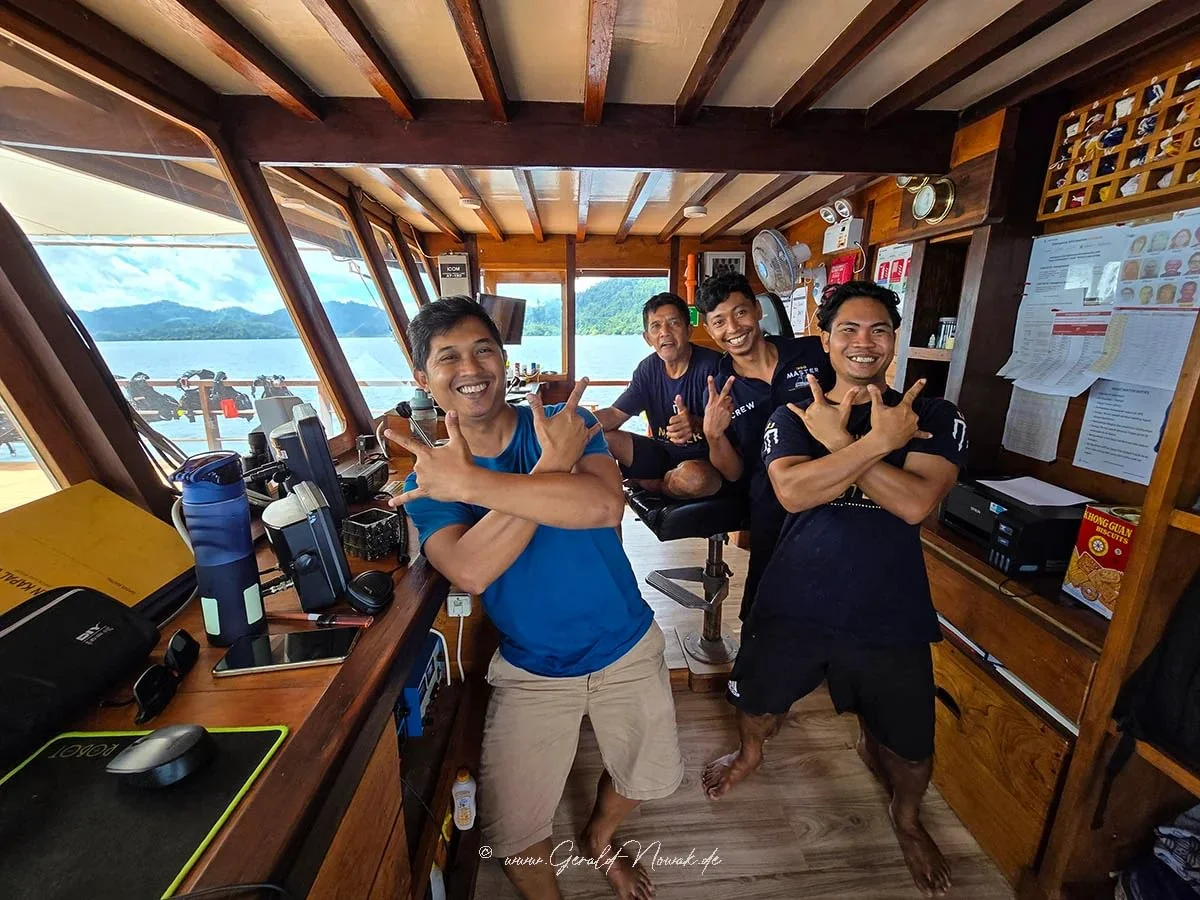I had seen the picture-perfect postcards of the Maldives with the turquoise lagoons, the palms swaying over white sand, the tiny islands that look straight out of a Robinson Crusoe story. But what I heard more of, as a diver, was what can be found beneath the surface. I’d heard the legends passed between dive guides about Maldives liveaboard diving. Tales of manta congregations, drifting channels alive with life, and the promise of an adventure like no other.
As part of the Master Liveaboards team, I’ve had the privilege of exploring these atolls firsthand many times. Each time, each itinerary revealed a new side of the ocean. On one dive, I might find myself beside a gentle whale shark in South Ari Atoll. On the next, I could be hovering at a manta cleaning station as these graceful giants sweep past. Then, only a day later, I might be drifting on a thila bursting with colours with the largest school of fusiliers hanging by, while reef sharks come in and out.
Yet, every journey aboard Maldives Master still feels like the first. It is a constant reminder of why Maldives liveaboard diving remains the ultimate adventure for ocean lovers. Stepping onto a liveaboard in the Maldives, surrounded by endless blue and the wonders waiting below, I feel that same thrill every single time. It’s this constant variety, this sense of exploration from one atoll to the next, that makes liveaboard diving in the Maldives unlike anywhere else on Earth.
And this is where the Maldives truly earns its reputation as a bucket-list destination. It is the place where liveaboard diving delivers experiences more breathtaking than any postcard could ever capture.
Dive In:
Why is the Maldives unique?
If you’re looking for a liveaboard destination that delivers variety, excitement, and unforgettable marine encounters, the Maldives is it. Imagine diving among over 2,000 species of fish and more than 200 types of coral, while drifting past gentle giants like whale sharks and manta rays… With more than 1,000 recognised dive sites across 26 atolls and 1,192 stunning islands, you’ll have access to remote reefs that most resort divers can only dream of. And there is no repeating the same dive over and over in a week.
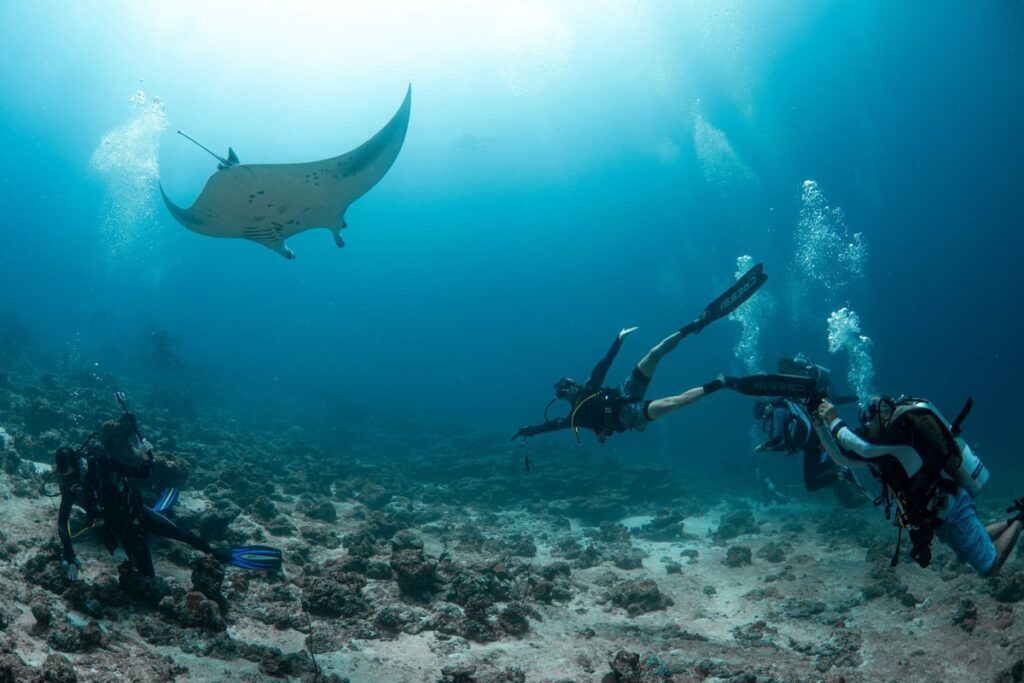
Each atoll in the Maldives offers its own underwater personality. Some are alive with fast-moving currents, while others shelter quiet lagoons and shallow coral gardens. Even after a week of diving, you’ll discover something new on every dive!
You’ll enjoy warm water year-round (27–30°C / 80–86°F), consistently high visibility of over 30 meters, and calm seas that make diving both comfortable and safe.
Whether you’re after shallow coral gardens, deep channels, dynamic drift dives, or night dives, the Maldives offers it all. You might spot a whale shark gliding past in South Ari Atoll, a manta feeding at Rangali Madivaru, or a tiny pipefish clinging to a coral branch. The variety is astonishing.
Why Liveaboards Are Essential in the Maldives
When it comes to exploring the atolls, Maldives liveaboard diving is the only way to truly experience the country’s full underwater diversity. Staying at a resort can give you access to a few local dive sites. But the Maldives are a rather large place…. A liveaboard allows you to explore multiple atolls in a single trip. You can reach remote sites that would otherwise require long transfers or several resorts. You can experience the full range of Maldives diving in just 7 to 10 days.
Unlike resort-based diving, a liveaboard lets you hop from atoll to atoll. You can log multiple dives per day in completely different environments. You can enjoy early-morning dives as the reefs wake, midday dives when currents bring the action, and night dives that transform the ocean into something mysterious and new.
One of the most unforgettable of these is the Alimatha night dive in Vaavu Atoll. There, dozens of nurse sharks circle you, joined by stingrays and trevallies in a surreal underwater ballet. Diving there, surrounded by these gentle giants, is an experience that stays with you long after you’ve surfaced.
And sometimes, the magic continues even after you’ve hung up your wetsuit. You might be relaxing on deck after dinner, chatting under the stars, when the crew suddenly calls out “Manta!” or “Whale shark!” Drawn by the lights at the stern, these visitors glide right up to the back of the boat, feeding in the glow. It’s one of those moments when you realise that, in the Maldives, the adventure never really ends.
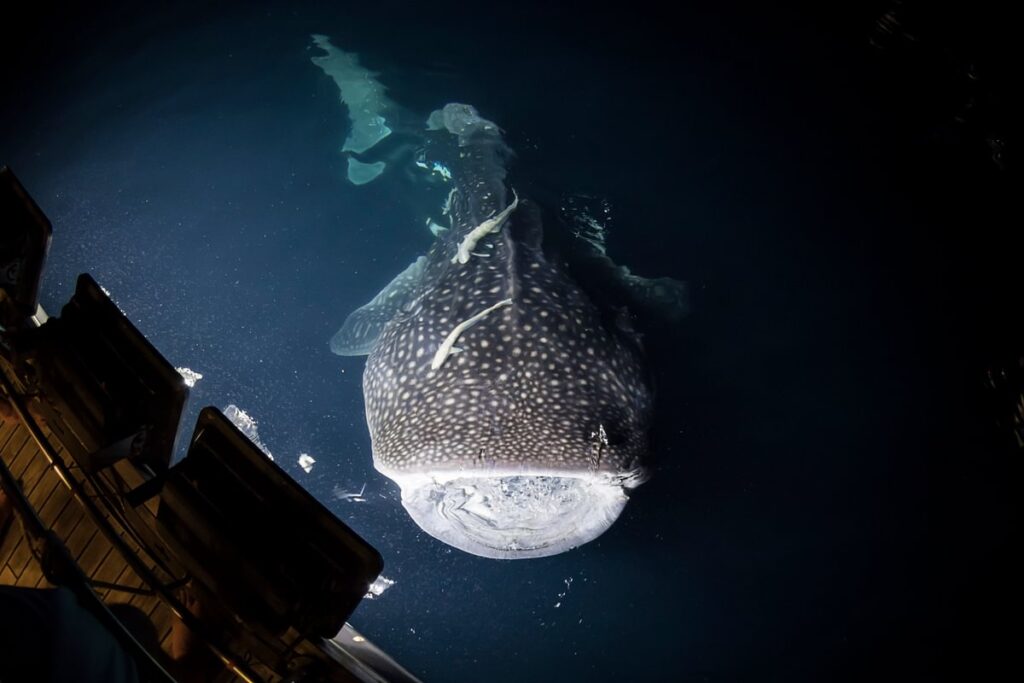
Liveaboards and Luxury Life Onboard Maldives Master
The liveaboard itself becomes your floating home in the Maldives, perfectly complementing your diving adventure. Your main vessel offers spacious cabins, deck lounges, chef-prepared meals, and postcard-perfect views from sunrise to sunset. It is truly heaven on earth as you glide past the islands. Meanwhile, the dhoni serves as your private dive centre. It carries all your tanks, equipment, and guides. This way, you can move quickly between dives while the main vessel remains your comfortable base.
A typical day unfolds with a rhythm of adventure and relaxation: wake with the sunrise and head out for the first dive, return for a hearty breakfast, enjoy a mid-morning dive, or relax in the sun before lunch. The afternoon brings another dive, and sometimes a night dive. After a sundowner, dinner is served, followed by a restful night so you can repeat this perfect rhythm again and again.
Throughout the day, the crew handles safety, logistics, and equipment, leaving you free to focus entirely on the dives, the marine life, and the stunning surroundings. By evening, you’ll feel part of the onboard community, sharing experiences, spotting wildlife together, and swapping stories under the stars.
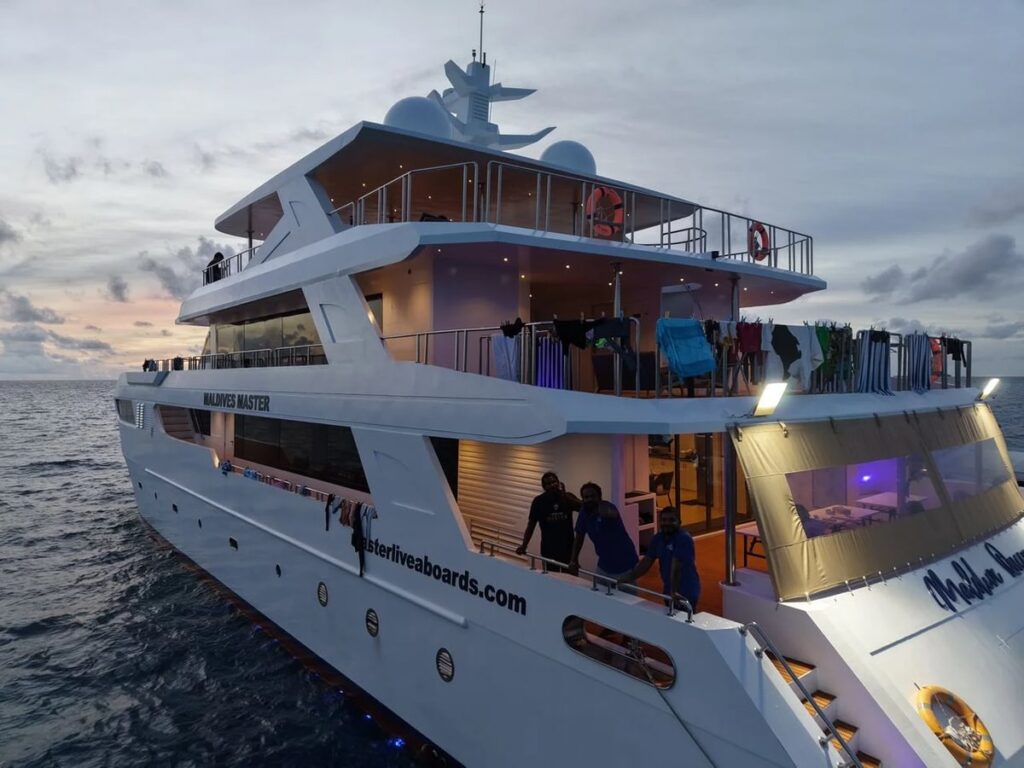
The Marine Wonderland and Pelagic Highlights
The Maldives is home to some of the most remarkable dive sites on the planet, offering experiences that stay with you long after you leave the water. Here, the reefs are alive with color and movement. There are dense schools of fusiliers to tiny nudibranchs and pipefish clinging to soft corals.
If it’s large pelagics you’re after, the Maldives won’t disappoint. Whale sharks are most reliably seen in South Ari Atoll and Hanifaru Bay (Baa Atoll), often gliding past reefs in shallow waters. Manta rays gather in impressive numbers at Rangali Madivaru (South Ari Atoll) and Fotteyo Kandu (Vaavu Atoll), feeding or stopping at cleaning stations. On any dive, you may also spot reef sharks, eagle rays, turtles, or schools of jacks and snappers moving as one.
Maldives liveaboards give you the flexibility to reach these prime sites consistently, with multiple dives each day and easy access to remote channels and pinnacles. You’ll have the chance to experience these encounters in crystal-clear water, often exceeding 30 meters of visibility, with warm water between 27–30°C (80–86°F). Every dive is a chance to witness the scale, energy, and grace of the Maldives’ marine life firsthand.

Seasonality and Best Times to Dive
The Maldives can be dived year-round, but knowing the seasons helps you plan the best itinerary for the experiences you want.
The Southwest Monsoon (May–November) brings wetter, plankton-rich waters, creating ideal conditions for manta ray and whale shark sightings. In contrast, the Northeast Monsoon (December–April) offers drier, calmer seas and excellent visibility. That season is better for exploring coral gardens and underwater photography.
Most itineraries are carefully scheduled by the liveaboard team, so you don’t need to plan a thing. Trips are timed to match the best seasonal conditions and maximize your chances of encountering key species. Certain atolls shine at different times. For example, Hanifaru Bay sees its largest manta gatherings during the plankton bloom months and your itinerary ensures you’re in the right place at the right time. With everything arranged, you can focus entirely on diving, the marine life, and enjoying the Maldives at its very best.
PRO TIPS: If you’re chasing mantas, plan your trip during the plankton-rich months of May to November. For photographers seeking maximum visibility and calm seas, the drier season from December to April is ideal. Either way, your liveaboard itinerary is scheduled to be in the right place at the right time. This way, you can focus on the dives rather than planning logistics.
Why the Maldives Remains the Pinnacle
Other dive destinations offer their own wonders, but the Maldives combines the full spectrum: big marine life, vast coral gardens, and pristine conditions. Mostly only accessible by liveaboard. Here, you can see whale sharks and mantas in a single day! You can also drift along untouched reefs, and return to a luxury vessel that feels like a home at sea.
The Maldives has also evolved responsibly. Marine conservation, reef protection, and sustainable tourism have grown in prominence. This ensures that the magic you experience today will be preserved for future generations. Our guest awareness also has increased. Nowadays, respectful diving practices now dominate the atolls. This is a sign of progress as meaningful as spotting a giant manta gliding overhead.
Every dive is a reminder of why this region has captivated divers for decades. A whale shark passing beneath a pink sunset, a school of jacks in the current, or the quiet calm of a coral garden at twilight. These are moments that stay with you long after you leave.
The Maldives is not just a destination; it is the pinnacle of liveaboard diving. For those ready to explore its atolls, encounter its pelagic giants, and enjoy life aboard a luxurious vessel, the journey begins here.
Explore Maldives Master itineraries and experience your own Maldivian adventure
Frequently Asked Questions
Most dive sites are suitable for Advanced Open Water divers or equivalent. But liveaboard guides tailor dives to experience levels, ensuring safety and enjoyment for all.
The Maldives can be dived year-round, but conditions vary:
– Southwest Monsoon (May–November): wetter, plankton-rich waters for manta and whale shark sightings.
– Northeast Monsoon (December–April): calm seas, excellent visibility, ideal for photography and reef diving.
You can expect a comfortable floating hotel. Spacious cabins, sun decks, lounges, chef-prepared meals, a dhoni for diving, and a daily rhythm of multiple dives, relaxation, and social time with fellow divers.
Liveaboards typically offer 2–4 dives per day, including early morning, midday, afternoon, and sometimes night dives. The dhoni allows for flexible dive schedules and access to multiple sites per day.
Absolutely! The crew and guides take care of logistics, equipment, and safety, letting even first-time liveaboard divers enjoy a seamless, stress-free experience.
About the Author
Written by:
Frederique Morisod
